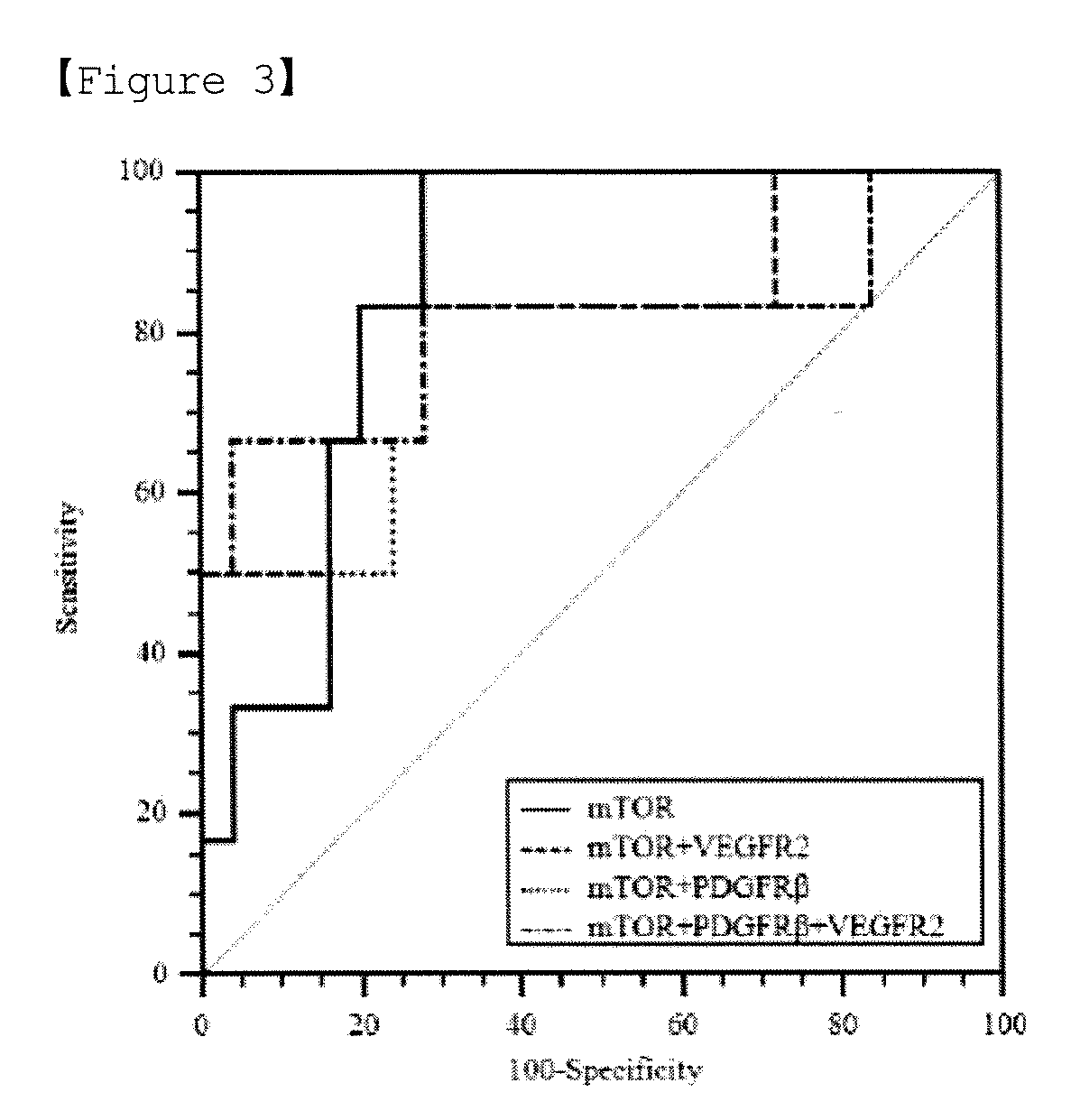Method for predicting sensitivity to vascular endothelial growth factor receptor inhibitor
a growth factor receptor and vascular endothelial technology, applied in the direction of heterocyclic compound active ingredients, drug compositions, biochemistry apparatus and processes, etc., can solve the problems of low treatment rate of about 2-3%, low treatment effect of approved and commercially available anticancer drugs against liver cancer, and difficult detection and treatment. time-consuming and labor-intensive problems, to achieve the effect of minimizing the side effects of liver cancer treatment and increasing treatment effects
- Summary
- Abstract
- Description
- Claims
- Application Information
AI Technical Summary
Benefits of technology
Problems solved by technology
Method used
Image
Examples
example 1
ction and cDNA Synthesis
[0058]From 31 liver cancer patients who were diagnosed as having liver cancer, received hepatectomy or liver transplantation, showed recurrence of liver cancer, and received treatment with Nexavar (sorafenib) in Ajou University Medical Center, Korea University Anam Hospital and Keimyung University Dongsan Medical Center, liver cancer tissues were obtained under informed consent. In the following manner, RNA was extracted from each of the tissues and cDNA was synthesized therefrom.
[0059]Total RNA was extracted from liver cancer tissue and the surrounding normal tissue using an RNeasy Mini kit (Qiagen, Germany) according to the manufacturer's instructions. The extracted total RNA was quantified using Bioanalyzer 2100 (Agilent Technologies, USA). In the extraction step, the RNA extract was treated with DNase I to remove genomic DNA. Each sample comprising 4 μg of total RNA was incubated with 2 μl of 1 μM oligo d(T)18 primer (Genotech, Korea) at 70° C. for 7 minu...
example 2
ive Real-Time PCR
[0060]In order to measure the mRNA expression level of mTOR, VEGFR2, PDGFRβ, FGFR1, cKIT, EGFR or cRAF, for each of the cDNA samples obtained in Example 1, the gene markers shown in Table below were amplified by real-time PCR using PRISM 7900HT (Applied Biosystems, USA) according to the manufacturer's instructions.
[0061]Real-time PCR analysis was performed using a total of 10 μl of a volume consisting of 5 μl of 2× TaqMan gene expression master mix (Applied Biosystems, USA), 1 μl of each of 5 μM forward and reverse primers, 1 μl of 1 μM probe (Genotech, Korea) and 2 μl of cDNA (the same amount of water as control). The PCR amplification was performed by denaturation at 95° C. for 10 minutes, followed by cycle reactions consisting of denaturation at 95° C. for 15 sec and synthesis at 60° C. for 1 minute. The primer and probe sequences were designed using Primer Express 3.0 (Applied Biosystems, USA), and all the probe sequences were labeled with FAM at the 5′ end and ...
example 3
al Analysis
[0064]Using the expression levels (2−ΔCt) of the markers obtained in Example 2, a total of four statistical analyses (i.e., individual gene expression distribution analysis, ROC curve analysis, treatment benefit score analysis, and ROC curve analysis of treatment benefit scores) were performed in the following manner.[0065](1) Analysis of Expression Distributions of Individual Genes
[0066]In order to examine the correlation between the therapeutic effect of sorafenib and the expression levels (2−ΔCT) of the individual markers, the expression levels of the seven individual markers and the distribution thereof were analyzed for responders to sorafenib and non-responders to sorafenib, respectively, and the results of the analysis are shown in FIG. 1.
[0067]FIG. 1 shows the results of analyzing the mRNA expression levels of seven genes (i.e., mTOR, VEGFR2, PDGFRβ, FGFR1, cKIT, EGFR and cRAF) for responders and non-responders.
[0068]When expression of each of these markers showed...
PUM
| Property | Measurement | Unit |
|---|---|---|
| volume | aaaaa | aaaaa |
| volume | aaaaa | aaaaa |
| volume | aaaaa | aaaaa |
Abstract
Description
Claims
Application Information
 Login to View More
Login to View More - R&D
- Intellectual Property
- Life Sciences
- Materials
- Tech Scout
- Unparalleled Data Quality
- Higher Quality Content
- 60% Fewer Hallucinations
Browse by: Latest US Patents, China's latest patents, Technical Efficacy Thesaurus, Application Domain, Technology Topic, Popular Technical Reports.
© 2025 PatSnap. All rights reserved.Legal|Privacy policy|Modern Slavery Act Transparency Statement|Sitemap|About US| Contact US: help@patsnap.com


